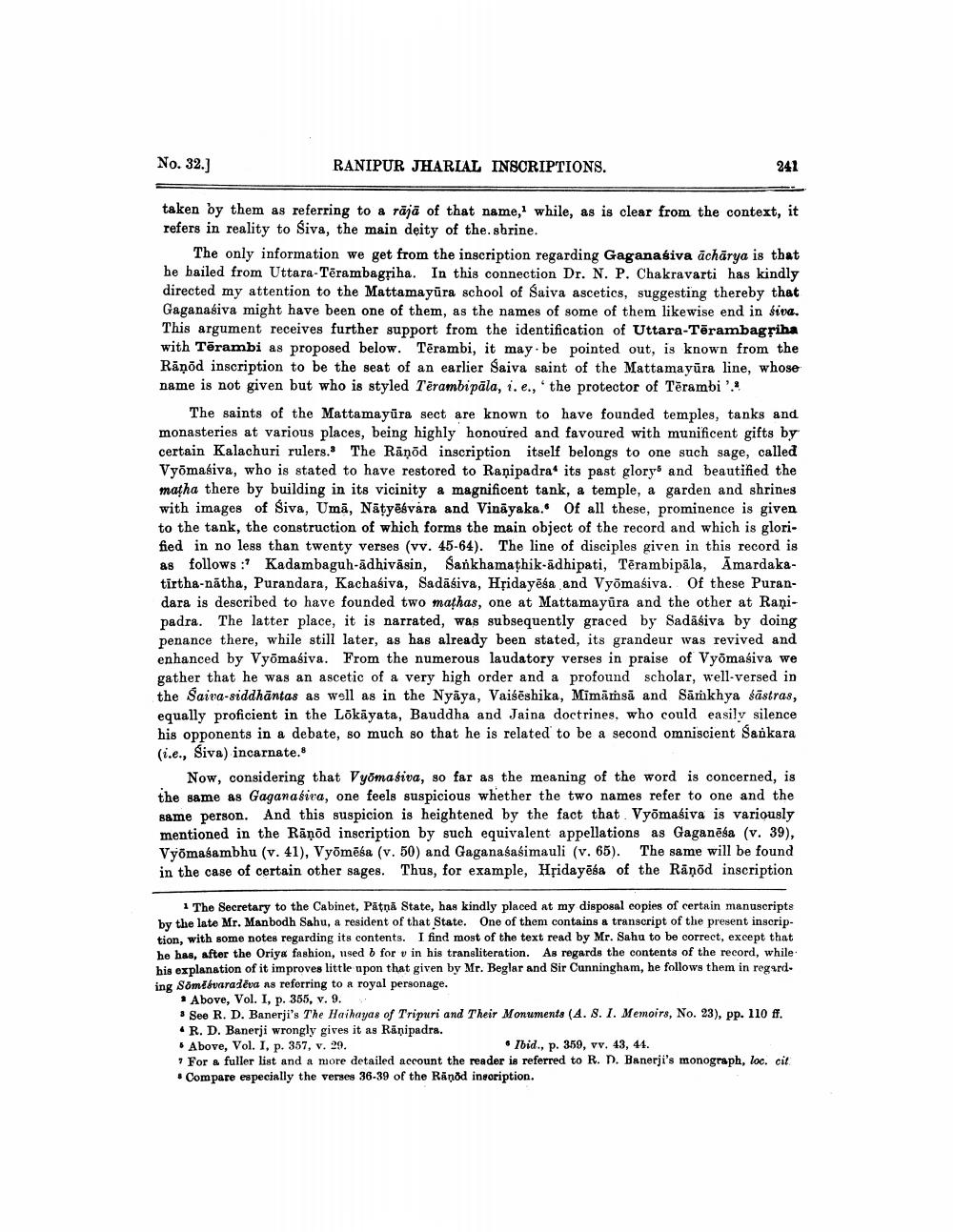________________
No. 32.)
RANIPUR JHARIAL INSCRIPTIONS.
241
taken by them as referring to a rājā of that name, while, as is clear from the context, it refers in reality to Siva, the main deity of the shrine.
The only information we get from the inscription regarding Gaganaśiva acharya is that he bailed from Uttara-Tērambagriha. In this connection Dr. N. P. Chakravarti has kindly directed my attention to the Mattamayüra school of Saiva ascetics, suggesting thereby that Gaganasiva might have been one of them, as the names of some of them likewise end in siva. This argument receives further support from the identification of Uttara-Tērambagriba with Tērambi as proposed below. Tērambi, it may be pointed out, is known from the Rāņod inscription to be the seat of an earlier Saiva saint of the Mattamayūra line, whose name is not given but who is styled Tērambipala, i.e., 'the protector of Tērambi '.!
The saints of the Mattamayūra sect are known to have founded temples, tanks and monasteries at various places, being highly honoured and favoured with munificent gifts by certain Kalachuri rulers. The Rāņod inscription itself belongs to one such sage, called Vyomasiva, who is stated to have restored to Ranipadrao its past glory and beautified the matha there by building in its vicinity a magnificent tank, a temple, a garden and shrines with images of Siva, Umā, Nātyēsvara and Vināyaka. Of all these, prominence is given to the tank, the construction of which forms the main object of the record and which is glorified in no less than twenty verses (vv. 45-64). The line of disciples given in this record is as follows :' Kadambaguh-adhivāsin, Sankhamathik-adhipati, Tērambipāla, Amardakatirtha-nātha, Purandara, Kachasiva, Sadāśiva, Hșidayēša and Vyömasiva. Of these Purandara is described to have founded two mathas, one at Mattamayūra and the other at Ranipadra. The latter place, it is narrated, was subsequently graced by Sadasiva by doing penance there, while still later, as has already been stated, its grandeur was revived and enhanced by Vyömasiva. From the numerous laudatory verses in praise of Vyömasiva we gather that he was an ascetic of a very high order and a profound scholar, well-versed in the Saiva-siddhāntas as well as in the Nyāya, Vaiśēshika, Mimāmsā and Samkhya sāstras, equally proficient in the Lökäyata, Bauddha and Jaina doctrines, who could easily silence his opponents in a debate, so much so that he is related to be a second omniscient Sankara (i.e., Siva) incarnate.
Now, considering that Vyömasiva, so far as the meaning of the word is concerned, is the same as Gaganasira, one feels suspicious whether the two names refer to one and the game person. And this suspicion is heightened by the fact that. Vyömasiva is variously mentioned in the Rāņod inscription by such equivalent appellations as Gaganēsa (v. 39), Vyömasambhu (v. 41), Vyömēba (v. 50) and Gaganaśasimauli (v. 65). The same will be found in the case of certain other sages. Thus, for example, Hridayēsa of the Rānod inscription
1 The Secretary to the Cabinet, Pātņā State, has kindly placed at my disposal copies of certain manuscripts by the late Mr. Manbodh Sahu, a resident of that State. One of them contains a transcript of the present inscription, with some notes regarding its contents. I find most of the text read by Mr. Sahu to be correct, except that he has, after the Oriya fashion, nised b for v in his transliteration. As regards the contents of the record, while his explanation of it improves little upon that given by Mr. Beglar and Sir Cunningham, he follows them in regard. ing Soměsvaradēva as referring to a royal personage.
* Above, Vol. I, p. 355, v. 9. * See R. D. Banerji's The Haihayae of Tripuri and Their Monuments (A. 8. I. Memoirs, No. 23), pp. 110 ff. .R. D. Banerji wrongly gives it as Ranipadra. • Above, Vol. I, p. 357, v. 29.
• Ibid., p. 359, vv. 43, 44. For a fuller list and a more detailed account the reader is referred to R. D. Banerji's monograph, loc. cit • Compare especially the verses 36-39 of the Rānod inscription.




